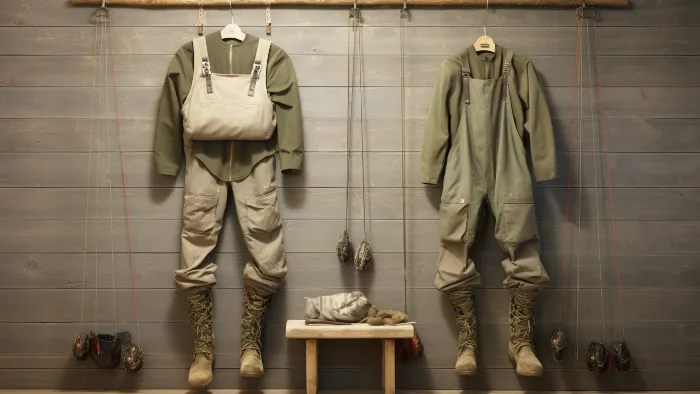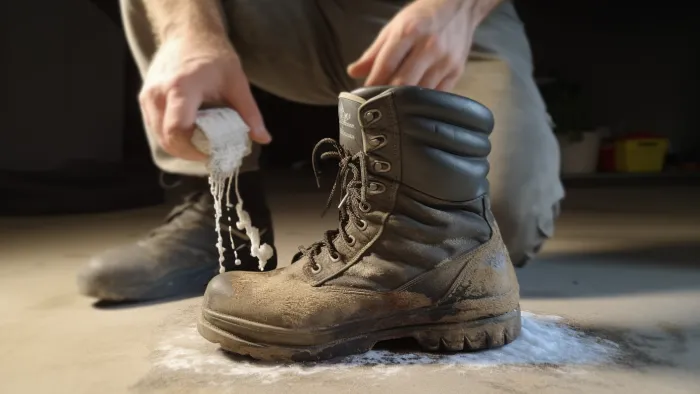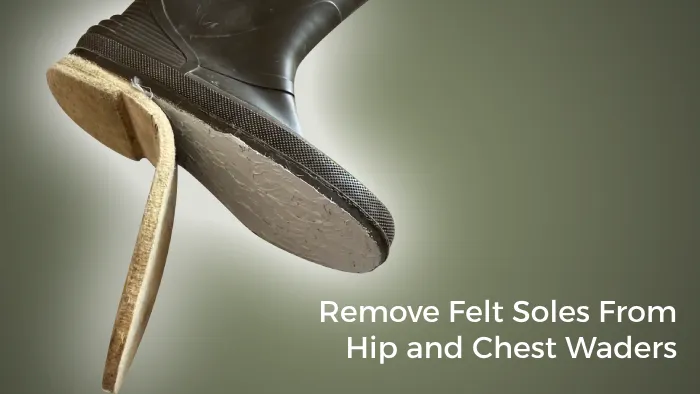How to Keep Wader Boots From Cracking: 10 Tips for Fisherman
Did you know that 70% of fishing wader boots crack within the first year of use? Don’t let your boots suffer the same fate. So, how can you keep your fishing wader boots from cracking?
Make sure to clean them regularly to remove dirt and debris that can cause damage. And always dry them thoroughly before storing them to prevent moisture buildup.
Also, avoid folding or bending the boots excessively, as this can weaken the material. You can apply a conditioner specifically designed for wader boots that can help keep them supple and prevent cracking.
Here, we will discuss how to keep your fishing wader boots from cracking. From simple maintenance tips to DIY methods, we’ve got you covered.
How Do You Keep Your Wader Boots From Cracking: Ten Tips for Angler

As an angler, you know how important it is to have well-maintained fishing wader boots. If exposed to the elements for too long, they can start to crack and become unusable. There are a few key tips to follow to keep your fishing wader boots from cracking:
- Tips 01: Clean them regularly
- Tips 02: Dry thoroughly
- Tips 03: Avoid folding or bending
- Tips 04: Apply conditioner
- Tips 05: Avoid chemicals
- Tips 06: Inspect for wear
- Tips 07: Proper storage
- Tips 08: Use boot liners or insoles
- Tips 09: Avoid overstretching
- Tips 10: Rotate your boots
Let’s see each of these tips in more detail:
Tips 01: Clean Them Regularly
Regularly rinsing off mud, sand, or saltwater from your wader boots with clean water helps prevent abrasion and potential cracking. When you’re out fishing, your wader boots will inevitably get dirty. But taking a few minutes to rinse them off after each trip can greatly affect their longevity.
Mud and sand can act like sandpaper, causing friction and destroying the material. Saltwater, on the other hand, can be corrosive and lead to cracks. By simply using clean water to remove these substances, you’re eliminating the risk of debris settling and causing damage.
Tips 02: Dry Thoroughly
Ensure you hang your wader boots inside out in a cool, dry, and well-ventilated area to prevent them from drying out and cracking.
After a day of fishing, it’s important to thoroughly dry your boots to maintain their quality and durability. Start by removing any excess moisture by patting them dry with a towel or shaking off any water.
Next, turn them inside out to allow air to circulate and promote faster drying. Avoid direct sunlight and high heat sources, as they can cause the material to become brittle and susceptible to cracking.
Instead, find a cool, dry spot with good airflow, such as a laundry room or garage. Leave your boots to dry completely before storing them, ensuring they are completely moisture-free.
Tips 03: Avoid Folding or Bending
When storing your boots, be careful not to fold or bend them excessively, as this can weaken the material and lead to cracks over time.
To keep your fishing wader boots from cracking, it’s important to store them properly. Instead of folding them or stuffing them into tight spaces, try to store them upright or hang them. This will help maintain their shape and prevent unnecessary stress on the material.
If you have limited storage space, consider investing in boot trees or inserts to keep them upright. It’s also a good idea to clean and dry your boots thoroughly before storing them, as any leftover moisture can contribute to cracking.
Tips 04: Apply Conditioner
To maintain the quality of your fishing wader boots, applying a conditioner specifically designed for the material is important. This will help keep the boots supple and prevent cracking.
Here are three tips to consider when applying conditioner to your fishing wader boots:
- Clean the boots: Before applying the conditioner, make sure the boots are clean and free from any dirt or debris. Use a mild soap and water to gently clean the surface, and allow the boots to dry completely before proceeding.
- Apply the conditioner evenly: Use a soft cloth or sponge to apply the conditioner onto the boots. Start from the top and work your way down, making sure to cover the entire surface. Apply a thin, even layer to avoid any excess buildup.
- Follow the manufacturer’s instructions: Different conditioners may have different application methods and drying times. Always read and follow the instructions provided by the manufacturer to ensure the best results and to avoid damaging the boots.
Tips 05: Avoid Chemicals
Avoid contact with harsh chemicals such as gasoline, oil, and solvents, as they can degrade the materials in your fishing wader boots and contribute to their cracking.
Chemicals like these can potentially weaken the integrity of the boot’s material, making them more susceptible to damage.
Tips 06: Inspect for Wear
Inspecting your boots for wear is crucial in preventing them from cracking. Over time, exposure to water, rocks, and other elements can cause the boots to deteriorate.
By identifying any thinning areas or weak spots early on, you can take the necessary steps to prevent further damage. If you notice any cracks, it’s important to address them immediately. Ignoring cracks can lead to leaks and potential damage to your feet.
Regularly inspecting your wader boots and promptly addressing any signs of wear will help prolong their lifespan and ensure they continue to provide you with the protection you need while fishing.
Tips 07: Proper Storage

When storing your fishing wader boots for an extended period, make sure they’re completely dry and clean to prevent damage. Moisture can cause the boots to crack and deteriorate over time.
To ensure they are dry, wipe them down with a clean cloth and allow them to air dry thoroughly before storing. It’s important to remove any dirt, mud, or debris from the boots as well, as they can attract moisture and promote mold or mildew growth.
Once they are dry and clean, store your boots in a cool, dry place away from direct sunlight, heat, and extreme temperatures. This will help preserve the integrity of the boots and extend their lifespan.
With proper storage, your fishing wader boots will be ready for your next fishing adventure.
Tips 08: Use Boot Liners or Insoles
Using boot liners or insoles is a great way to add extra cushioning and protection to your fishing wader boots, reducing stress on the material and helping to prevent cracks. Here are three reasons why you should consider using boot liners or insoles for your fishing wader boots:
- Comfort: Boot liners or insoles provide additional cushioning, making your boots more comfortable to wear for long periods. They help absorb shock and reduce foot fatigue, allowing you to focus on your fishing without discomfort.
- Insulation: In colder weather conditions, boot liners or insoles can provide added insulation, keeping your feet warm and protected. This is especially important when fishing in cold rivers or lakes, as cold feet can be uncomfortable and even dangerous.
- Hygiene: Boot liners or insoles can help to keep your boots clean and fresh. They can absorb sweat and odor, preventing bacteria growth and prolonging your boots’ lifespan.
Tips 09: Avoid Overstretching
To avoid causing stress points that may lead to cracking, be careful not to excessively stretch or pull on the material of your fishing wader boots when putting them on or taking them off.
The material of your boots is designed to be durable and resistant to wear and tear, but it still has its limits. Overstretching or pulling on the material can weaken it and make it more prone to cracking or tearing.
When putting on your boots, gently slide your foot into the boot without forcing it. If you find the boot too tight, try using a boot horn or lubricating the inside with a bit of talcum powder.
Tips 10: Rotate Your Boots
Having multiple pairs of wader fishing boots and rotating them is a good way to prevent excessive wear and tear. By doing this, you can extend the lifespan of your boots and avoid costly replacements.
Here are some reasons why rotating your boots is beneficial:
- Drying Time: Rotating boots allow each pair to fully dry between uses, preventing moisture buildup and reducing the risk of cracking.
- Rest and Recovery: Like your feet need rest, so do your boots. By giving them time to recover, you minimize the chances of material fatigue and increase their overall durability.
- Alternating Terrain: Different fishing spots may require different types of boots. By rotating between pairs designed for different terrains, you ensure you always have the right footwear for the job.
- Style Versatility: Rotating boots allow you to switch up your style and keep your fishing gear fresh and exciting.
Can I use household glue to fix my cracked fishing wader boots?

While household glue might temporarily hold cracked fishing wader boots together, it may not provide a lasting repair due to its unsuitability for rubber materials. Rubber-specific repair adhesives or patch kits are recommended for a more effective and durable fix.
Household glues are typically designed for bonding porous materials such as wood or paper and may not adhere properly to rubber surfaces. Moreover, rubber materials often require specialized adhesives that withstand water, flexing, and harsh outdoor conditions.
Using a rubber-specific repair adhesive or patch kit will ensure a stronger and longer-lasting bond, preventing further cracking and extending the lifespan of your fishing wader boots.
Are there any DIY methods to prevent fishing wader boots from cracking?
Storing your boots in a cool, dry place and cleaning them after each use can help prevent cracks. However, you can also try some DIY methods to further protect your fishing wader boots from cracking.
Here are four suggestions to consider:
- Apply a thin layer of petroleum jelly or silicone spray to the boots. This can help keep the rubber or neoprene material moisturized and flexible.
- Avoid exposing your boots to harsh sunlight for extended periods of time. UV rays can cause the material to deteriorate and eventually crack.
- Use a boot conditioner specifically designed for rubber or neoprene. These products can provide additional protection against cracking and also help restore the boots’ appearance.
- Store your boots away from extreme temperatures. High heat or freezing cold can weaken the material and make it more prone to cracking.
Are rubber wader boots more prone to cracking than neoprene ones?
You should regularly clean and moisturize your rubber wader boots to prevent cracks. They are more susceptible to UV damage compared to neoprene.
Rubber wader boots can develop cracks over time when exposed to harsh sunlight. UV radiation can cause the rubber to deteriorate and become brittle, leading to the formation of cracks.
After each fishing, clean your rubber wader boots and apply a rubber conditioner or protectant. This will help to keep the rubber supple and resistant to cracking. Additionally, avoid leaving your boots out in direct sunlight for extended periods.
How often should I inspect my fishing wader boots for cracks?
Inspect your fishing wader boots for cracks and signs of wear after each use to catch any issues early and address them before they worsen. Regular inspections are crucial in maintaining the integrity of your boots and preventing them from cracking.
The frequency of inspections depends on how often you use your boots. If you fish frequently or in harsh conditions, it’s advisable to inspect your boots at least once a week. However, if you fish less frequently or in milder conditions, once every two weeks should suffice.
During the inspection, pay close attention to the areas that are most prone to cracking, such as the seams and the soles. Look for any visible cracks, tears, or signs of wear. If you notice any issues, it’s important to address them promptly to prevent further damage and extend the lifespan of your fishing wader boots.
Protect Your Fishing Experience with Proper Wader Boot Maintenance
Taking proper care of your fishing wader boots is essential to prevent cracking. Regularly inspecting them for cracks and using appropriate methods, such as household glue or DIY techniques, can help extend their lifespan.
Remember, rubber wader boots may be more prone to cracking than neoprene ones, so extra care is necessary. By staying vigilant and implementing these preventative measures, you can ensure that your fishing wader boots remain in good condition for many fishing trips to come.
As the saying goes, ‘An ounce of prevention is worth a pound of cure.’







